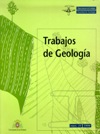Abstract
The structural relationships between the Variscan basement and the Permo-Mesozoic cover around the Cantabrian Zone show that they were jointly deformed during the Alpine deformation. The Variscan basement was uplifted and internally deformed; this internal deformation usually caused reactivation of earlier structures. Thus, Variscan folds were tightened, giving rise to steepening and reactivation of previously folded Variscan thrusts, as a result of flexural-slip mechanisms. Moreover, normal faults related to the development of Permo-Mesozoic basins were inverted. Wherein the basement is mostly shaly, the Permo-Mesozoic cover developed its own structures, mainly buckle folds, whereas the basement played a passive role. In the basement, the amount of shortening during Alpine deformation was around 20% in most areas. This value is greater in the forelimb of a large-scale fault-propagation fold developed in the mountain front, and also close to the inverted normal faults, as a result of butressing. The Alpine deformation implies a remarkable modification of the Variscan structure in some places, giving rise up to 30º of dip increase for the Variscan thrusts.Downloads
Download data is not yet available.

